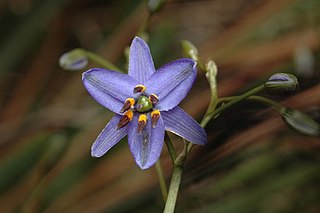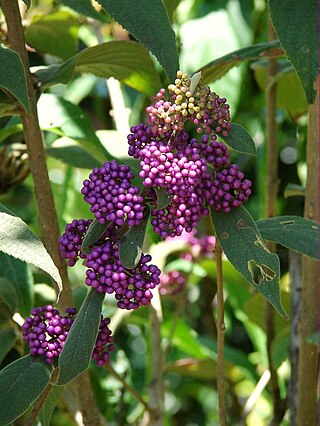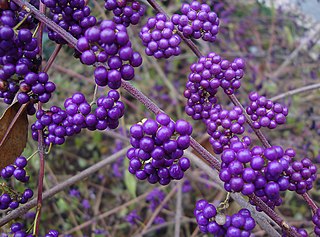
Sambucus is a genus of flowering plants in the family Adoxaceae. The various species are commonly referred to as elder, elderflower or elderberry.

Dendrobium is a genus of mostly epiphytic and lithophytic orchids in the family Orchidaceae. It is a very large genus, containing more than 1,800 species that are found in diverse habitats throughout much of south, east and southeast Asia, including China, Japan, India, the Philippines, Indonesia, Australia, New Guinea, Vietnam and many of the islands of the Pacific. Orchids in this genus have roots that creep over the surface of trees or rocks, rarely having their roots in soil. Up to six leaves develop in a tuft at the tip of a shoot and from one to a large number of flowers are arranged along an unbranched flowering stem. Several attempts have been made to separate Dendrobium into smaller genera, but most have not been accepted by the World Checklist of Selected Plant Families.

Syzygium cumini, commonly known as Malabar plum, Java plum, black plum, jamun, jaman, jambul, or jambolan, is an evergreen tropical tree in the flowering plant family Myrtaceae, and favored for its fruit, timber, and ornamental value. It is native to the Indian subcontinent and Southeast Asia, including Myanmar, Sri Lanka, Bangladesh and the Andaman Islands. It can reach heights of up to 30 metres (98 ft) and can live more than 100 years. A rapidly growing plant, it is considered an invasive species in many world regions.

Dianella is a genus of about forty species of flowering plants in the monocot family Asphodelaceae, commonly known as flax lilies. Plants in this genus are tufted herbs with more or less linear leaves and bisexual flowers with three sepals more or less similar to three petals and a superior ovary, the fruit a berry. They occur in Africa, South-east Asia, the Pacific Islands, New Zealand and Australia.

Callicarpa ampla, also called the capa rose, is a species of plant in the family Lamiaceae. It is found in Puerto Rico in the Caribbean region. It is threatened by habitat loss and is a critically endangered plant species.

Callicarpa americana, commonly called the American beautyberry, is an open-habitat, native shrub of the Southern United States which is often grown as an ornamental in gardens and yards. American beautyberries produce large clusters of purple berries, which birds and deer eat, thus distributing the seeds.

Callicarpa bodinieri, or Bodinier's beautyberry, is a species of flowering plant in the genus Callicarpa of the family Lamiaceae, native to West and Central China. Growing to 3 m (10 ft) tall by 2.5 m (8 ft) wide, it is an upright deciduous shrub with dark green leaves turning red in autumn (fall). In midsummer, small lilac flowers are produced in the leaf axils. But it is grown in gardens primarily for its small, decorative purple berries in tight clusters in autumn.

Callicarpa japonica, commonly known as East Asian beautyberry or Japanese beautyberry, is a plant in the mint family.

Callicarpa dichotoma, the purple beautyberry or early amethyst, is a species of beautyberry. They are cultivated as garden shrubs. The flowers are pink to white. The berries which are small drupes are purple. The fruits grow closely together in large clusters. The fruit provides food for wild life. The berries are edible and have a mild taste. This species can be found in China, Vietnam, Korea and Japan.

Callicarpa cathayana is a species of beautyberry. It is grown in gardens and parks as an ornamental plant for its decorative pink flowers and berries. The purple berries are a drupe. They are not edible for humans. Birds eat the berries and disperse the seeds. The species are endangered in the wild. Callicarpa cathayana is native to China.
Callicarpa longifolia is a species of beautyberry. It ranges from the Himalayas, east to Japan and south to Queensland. It is grown in yards and gardens as an ornamental plant. The roots are used as an herbal medicine to treat diarrheas.
Callicarpa erioclona is a species of beautyberry native to Vietnam, Borneo, Sulawesi, Java, Philippines, New Guinea and the Bismarck Archipelago. It produces small berries that grow in tight clusters. The fruit is edible, but is not commercially grown or sold in markets. The flowers are light-pink to white. The leaves can be mixed with coconut oil to treat open wounds.

Callicarpa acuminata is a species of beautyberry native to Latin America from Mexico to Bolivia. Unlike the other species of this genus, C. acuminata produces small berry-like fruits which can be dark-purple or dark blue-purple. The fruit can sometimes be white. The flowers blooms are white. The fruit grow in tight clumps and sometimes resemble grapes. They are cultivated as garden trees.

Callicarpa nudiflora is a species of beautyberry that is grown as an ornamental plant. It is native to Southeast Asia. It is a perennial evergreen shrub that grows most prevalently in the Guangdong, Guanxi, and Hainan Provinces. In China it is known as Luo-hua-zi-zhu and is a staple in Chinese folk medicine utilized for its anti-inflammatory, antibacterial, cytotoxic, and hemostatic abilities.

Callicarpa pedunculata is a shrub or small tree in the Lamiaceae family native to both Queensland and New South Wales.
Callicarpa pentandra is a species of beautyberry tree. It is a tall, large tree. The leaves are oval-shaped and the flowers are violet. The berries are green when young but become bright pink to purple when ripe. It ranges from India, Southern China, and the Solomon Islands to Borneo. In Borneo its local names are Belau, Bilau, Guro and Kayu hobo.

Callicarpa shikokiana, commonly called Shikoku beautyberry or China beautyberry, is a plant species in the Lamiaceae and is native to China. It is a shrub with pink flowers in summer and purple fruit in the fall. The berry-like fruit is a drupe. It is cultivated in home gardens and national parks as an ornamental plant. The leaves turn yellow in the fall.

Ocimum americanum, known as American basil, lime basil, or hoary basil, is a species of annual herb in the family Lamiaceae. Despite the misleading name, it is native to Africa, the Indian Subcontinent, China, and Southeast Asia. The species is naturalized in Queensland, Christmas Island, and parts of tropical America.
Vitis betulifolia is a widely ranging species of liana in the grape family native to China where its habitat is forested or shrubby valleys and hillsides, at elevations from 600 to 3,600 metres.

Callicarpa (beautyberry) is a genus of shrubs and small trees in the family Lamiaceae. They are native to east and southeast Asia, Australia, Madagascar, southeast North America and South America.















